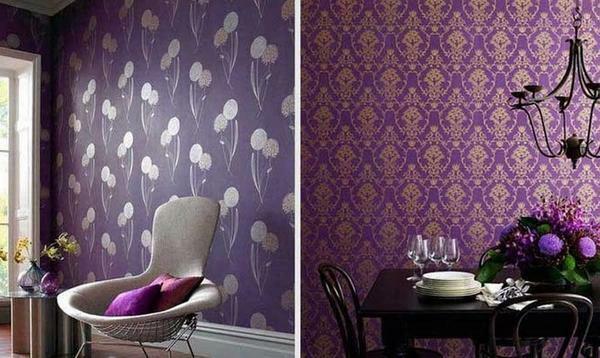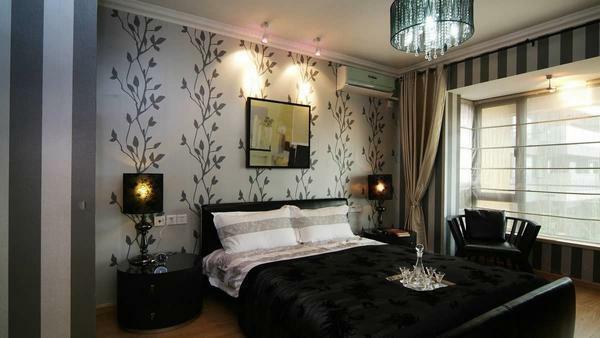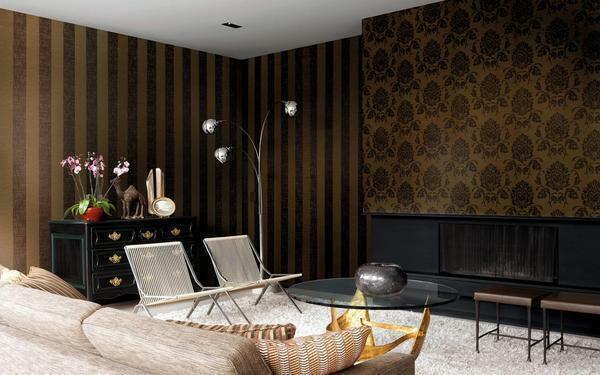
Specialists constantly work on the creation of new building and finishing materials that allow to implement luxurious and original solutions for the design of bathrooms and also have high performance. Ordinary paper wallpaper is no longer relevant, now it's time for fiberglass wallpaper. They are very popular among ordinary buyers, because they have unique qualities. About all the advantages and disadvantages of glassmaking, as well as how to glue glassworks, we will tell in this article.

What is glass wallpaper?
Steklooboi - a kind of finishing materials, which is made on the basis of fiberglass .They are treated with special glue from modified starch, which increases their strength, and also allows you to keep the shape before gluing to walls or ceiling.
Steklooboi are available in rolls. They are usually white, which becomes transparent when applied. The wallpaper is made of special glass based on quartz sand, dolomite, soda and lime. The glass passes the heating to a temperature of 1200 degrees, after which threads of different thickness are drawn from it, then a web is drawn from these threads. The technology allows you to weave textural canvases and dense mastic glass woolen cloths.



Pros
Basic properties of glass walls:
- durability - service life reaches 30 years;
- versatility;
- environmental safety;
- elasticity;
- incombustibility;
- are not afraid of temperature changes;
- high level of water resistance;
- high strength;
- resistance to the effects of various chemicals;
- is not susceptible to decay, mold or fungus formation;
- material structure misses steam, which positively affects the microclimate of the bathroom;
- they do not collect dust and dirt, because they have antistatic effect;
- can withstand up to 20 colors;
- is used as a basis for further painting or painting.

Types of
All glass masonry depending on the texture are divided into:
- smooth - these include fiberglass and spider web. This variety of glass walls is used to eliminate microcracks on walls or ceiling. Usually they are used in new buildings, resulting in a perfectly flat surface;
- embossed - are more durable than plain wallpaper. They are used at the final stage of wall or ceiling finishing.

Features of
The technology of pasting walls or ceilings with fiberglass wallpaper in many respects coincides with the pasting of ordinary wallpaper.
But to pay attention to some features:
- glue should be applied only on the surface of the walls, the application of glue is strictly forbidden on canvases;
- glass walls must be glued only butt-end;
- you need to leave allowances of 10 centimeters to be able to dock the pattern on the canvases. After that, everything that is superfluous is cut off;
- the junction between the glass walls can be horizontal or vertical;
- it is necessary to paint wallpaper two times, the time interval should be 12 hours;
- it is necessary to monitor the amount of glue or paint, because the thick layer will negatively affect the performance of wallpaper;
- the temperature in the bathroom should be between 18 and 25 degrees, and the humidity should not exceed 70 percent;
- must beware of drafts after the wallpaper is pasted.

It is not recommended to glaze the wall-papers on all walls of the bathroom. It is not recommended to cover the sections of the wall where the bath and washbasin are placed. Although this material is resistant to moisture, but with constant contact with water, the wallpaper can change appearance and peel off.
All other walls of the bathroom can be decorated with fiberglass wallpaper, which can be painted in any tone. To update the interior, you can repaint them in a different color or color them with stripes, combining several colors.

Steklooboi can be used for walls that are already painted with oil paint. But first you must prepare the surface. It is necessary to purchase a special compound that acts as a primer. The wall needs to be treated with a solution several times, with time intervals for good drying of each layer. Most bathrooms are often painted with oil paint, so do not remove it, just responsibly treat the surface preparation and glassworks will decorate the bathroom room for many years.
Choose the right glue
Only correctly selected glue can guarantee a reliable gluing of the material to different surfaces. Well-known manufacturers of glue, which is used for glassworks, is the company Nortex, Oscar, Lakra and Master Pro.
The undoubted advantages of this type of glue include high safety for others and absolute ecological purity. The composition of the glue includes special additives to protect the wallpaper from the appearance of mold and fungus.

When buying glue, it should be taken into account that one liter is enough for gluing 5-6 square meters of wallpaper. You can buy glue already in ready form. On sale also presented glue for fiberglass in the form of a dry powder, which is very easy to prepare according to the manufacturer's instructions. Of 100 grams of powder, three liters of finished glue is obtained. Powder is enough to pour cold water, stir well and after 10 minutes the glue is ready for use.

Wall Pasting
- Before using glass mural, it is necessary to inspect the walls. If the cracks are only 1 mm, then the alignment of additional materials can not be made, because the glass walls have excellent reinforcing properties. If the cracks are larger, then the walls should be leveled with the help of a putty, then sand it with sandpaper and primed.
- Walls in the bathroom, where the humidity is usually high, should be treated with a special formulation with antifungal properties.
- Prepare the adhesive preparation. It can be in the form of a powder or already in ready form.
- You need to find the front side of the canvas. Usually it is inside the roll. Some glassmaker manufacturers use special notes in the form of a gray or blue tape.
- Then cut the canvas, the size of which should be 5-10 centimeters more than the height of the wall, if there is a picture. For cutting, you can use a stationery knife or a well sharpened scissors.






Glueing wallpaper:
- Apply the adhesive only to the part of the wall where the canvas will be glued. You can use a special roller for this, so the glue will be evenly distributed, which will provide an excellent result of gluing. If there remain small sections of the wall without glue, then the glass walls very quickly begin to lag behind the wall.
- Wallpaper gluing is carried out using the technology of "butt".The first cloth is glued vertically, and then carefully smoothed with a plastic spatula or special roller. The edge does not need to be strongly pressed, because it will dock with the next cloth.
- Using a sharp knife, you need to cut off excess material from below and above. When carrying out this procedure, it is necessary to fix the pasted sheet with a spatula.
- Next you can take on the next canvas. The process is repeated. When the second sheet is glued to the wall, then you should carefully walk with a spatula or roller on the joint. Thus, all walls are glued.
- All wallpapers on walls should be primed with a special glue solution, which is made according to the instructions. This action will help to give the material a stiffness, as well as reduce paint consumption.
- Painting the wallpaper is done after the glue has completely dried out, and the wallpaper must be held firmly on the wall. Therefore, the first painting takes place 24 hours after wallpapering, and the second - not earlier than 12 hours after the first. Usually, acrylic, latex or water-based paint is used for painting glass walls. For painting, you can use a fur roller or an atomizer, which will make the process easier and faster. In the future, you can repaint the wallpaper up to 20 times. If they are damaged, for example, by children or animals, the staining will hide all the flaws.

Pasting of the ceiling
To simplify the process of gluing the ceiling with wallpaper, it is better to get the support of another person. One will serve from the bottom, and the second, standing on a table or stepladder, will already glue them on the ceiling. This approach will help speed up the process, because it will not be necessary to constantly slash down behind the next canvas.

Procedure:
- First, you need to stock up a comfortable stepladder or table to access the ceiling.
- Before using glass mural, it is necessary to prepare the pre-ceiling: to level, apply the putty and the primer of deep penetration.
- Cutting of the fiberglass wall is made, at the same time it is necessary to leave a margin of 5-10 centimeters to make the adjustment of the texture.
- The process of gluing the ceiling should be started at the opposite side of the door.
- It is possible to apply even lines on the ceiling using a level, then the canvassing will be done correctly. These lines will help to paste the first canvas.
- With the roller, the adhesive is applied only to the ceiling, because the web is already impregnated with starch, which has adhesive properties.
- Then the fiberglass is glued. It must be firmly pressed to the ceiling, and then, using a soft roller or plastic spatula, smooth out to eliminate air.
- The process of gluing is done only by butt.
- After gluing the wallpaper, it is necessary to cover the ceiling with a thick adhesive for strength and extra paint consumption at a later stage.
- The ceiling should be left to dry completely under normal room conditions.


